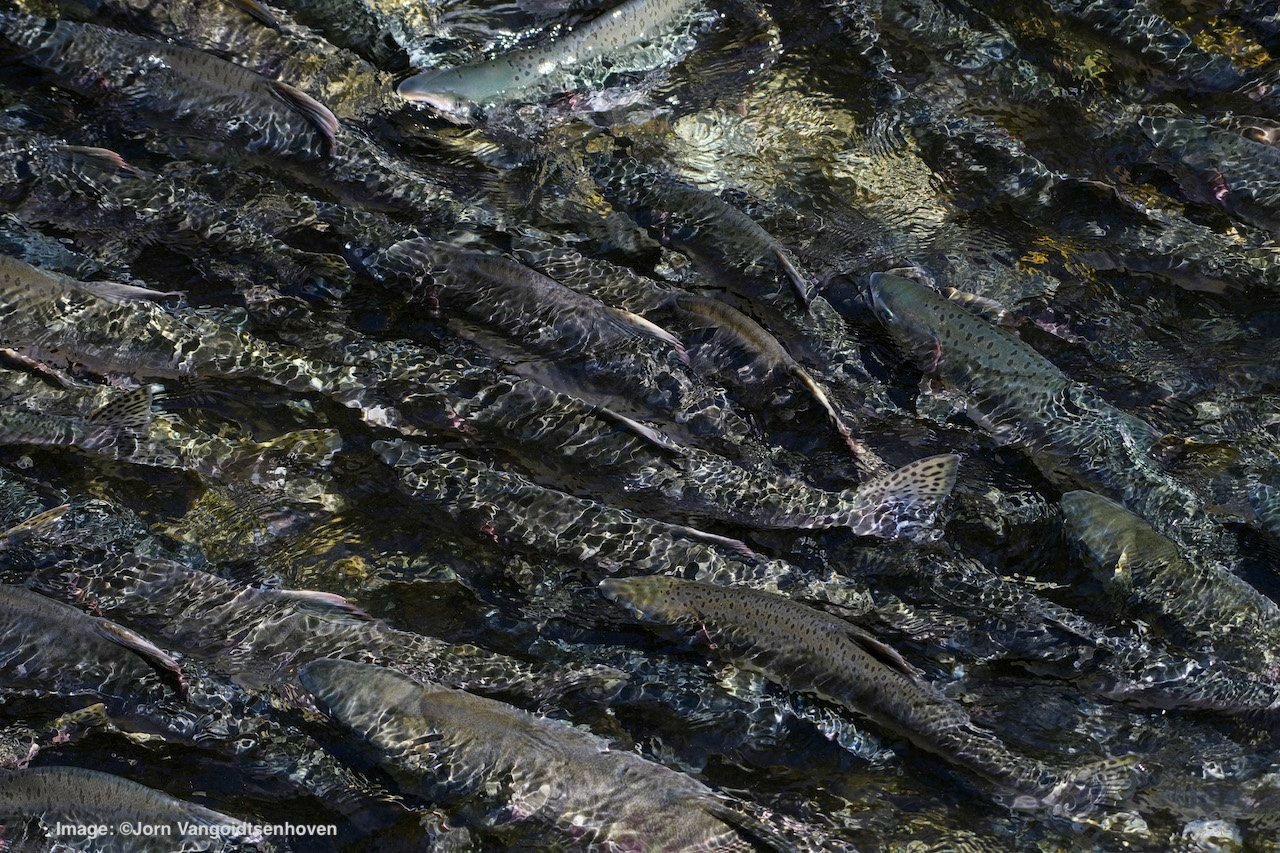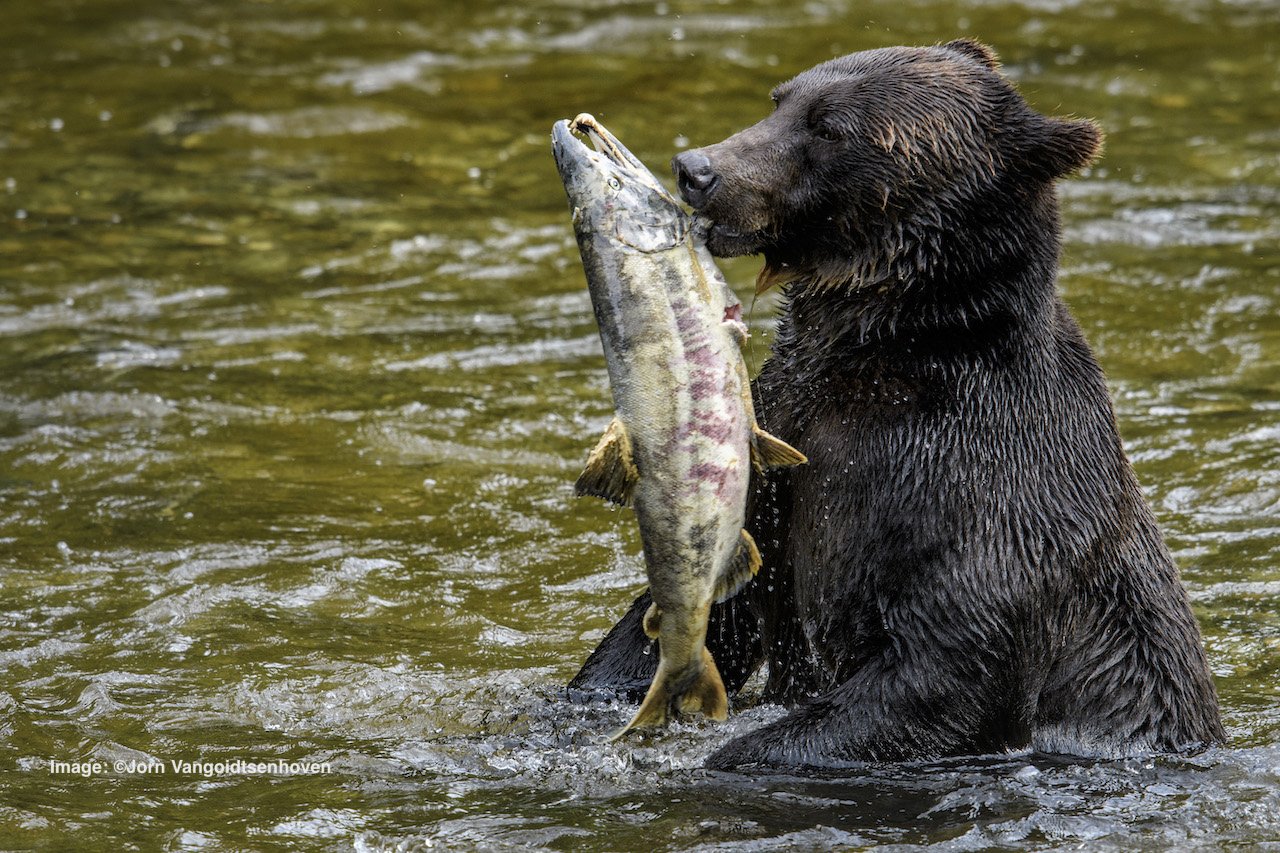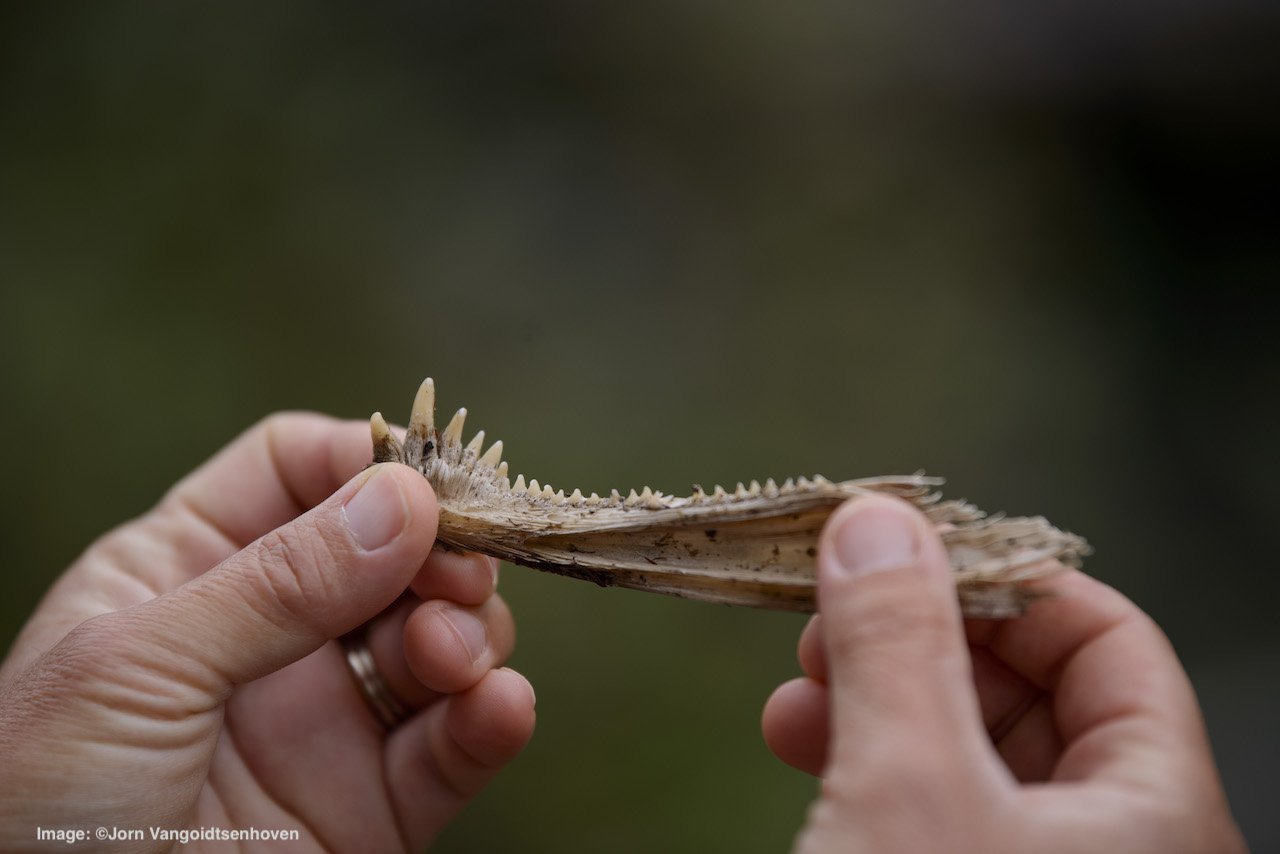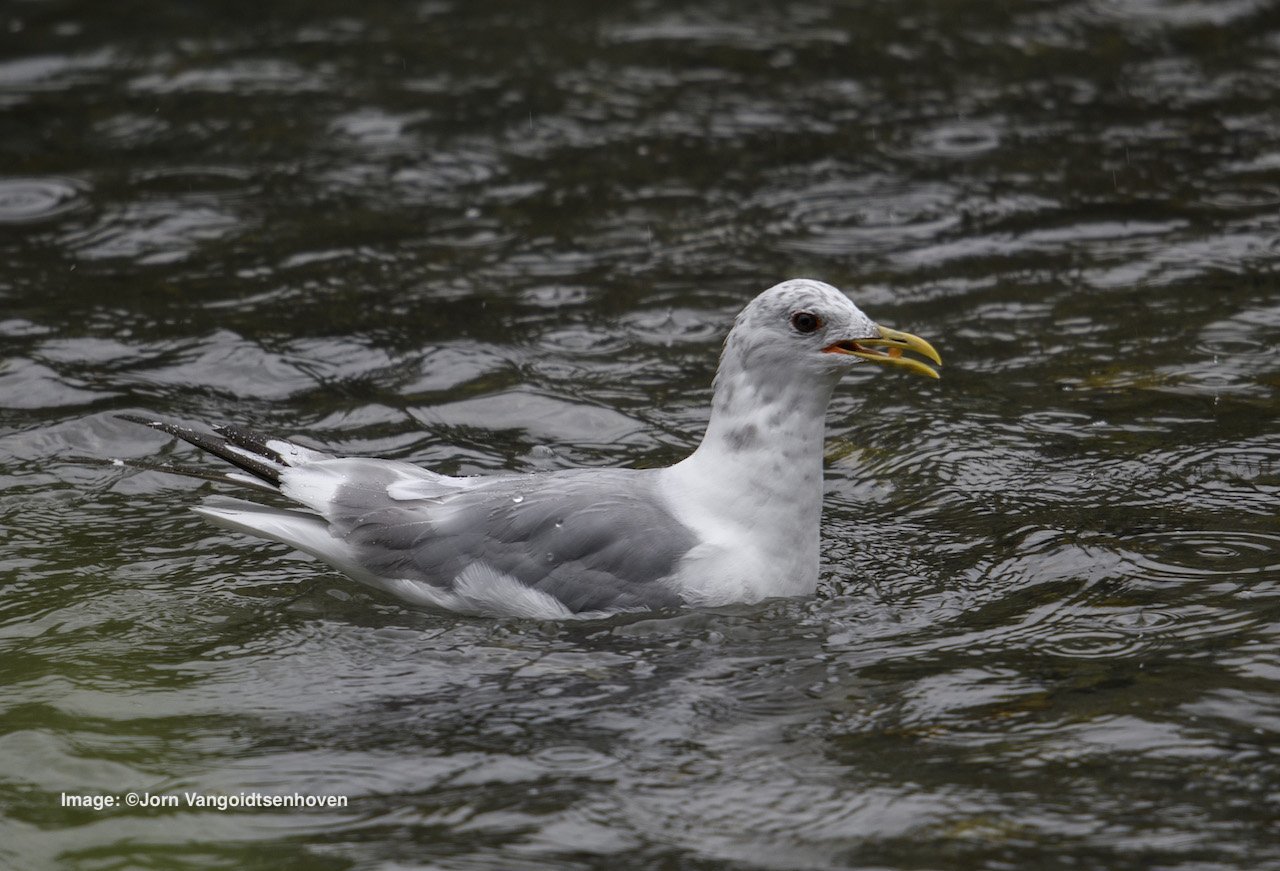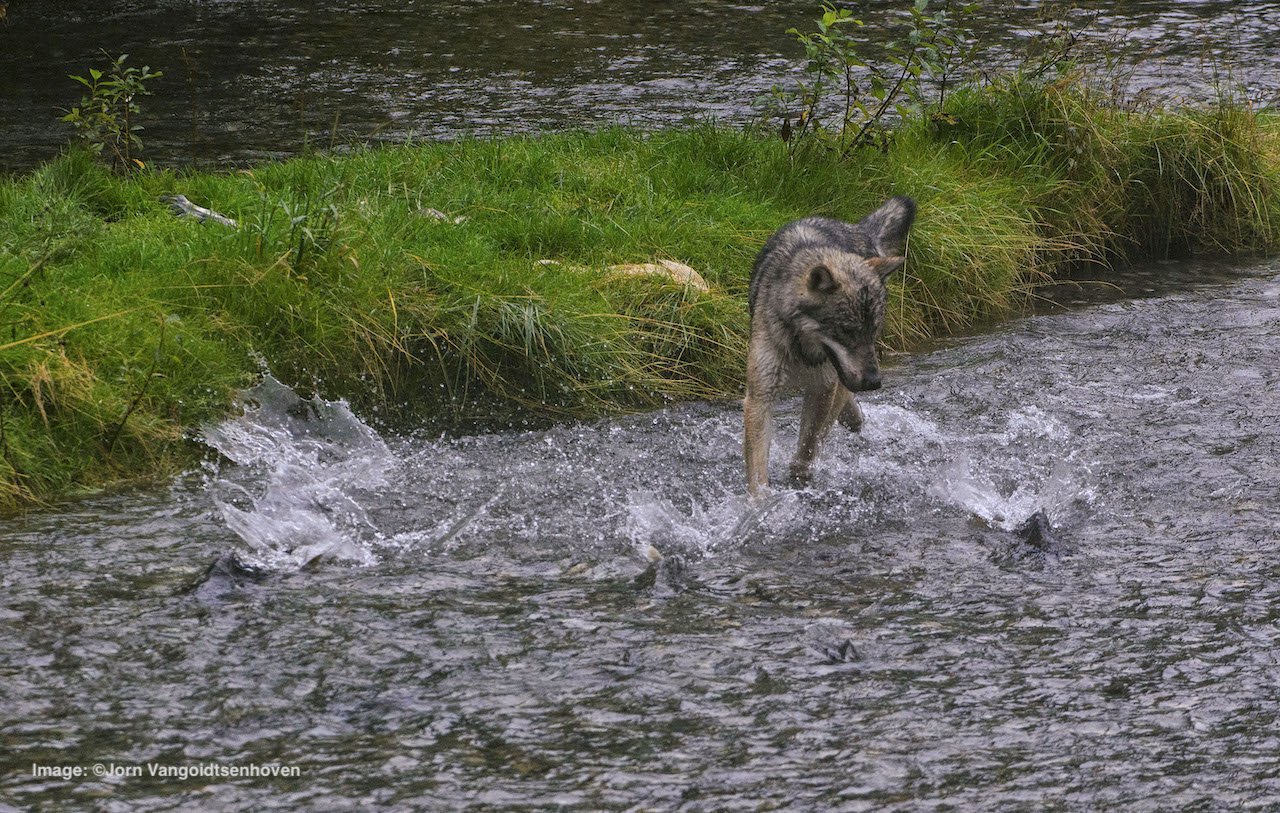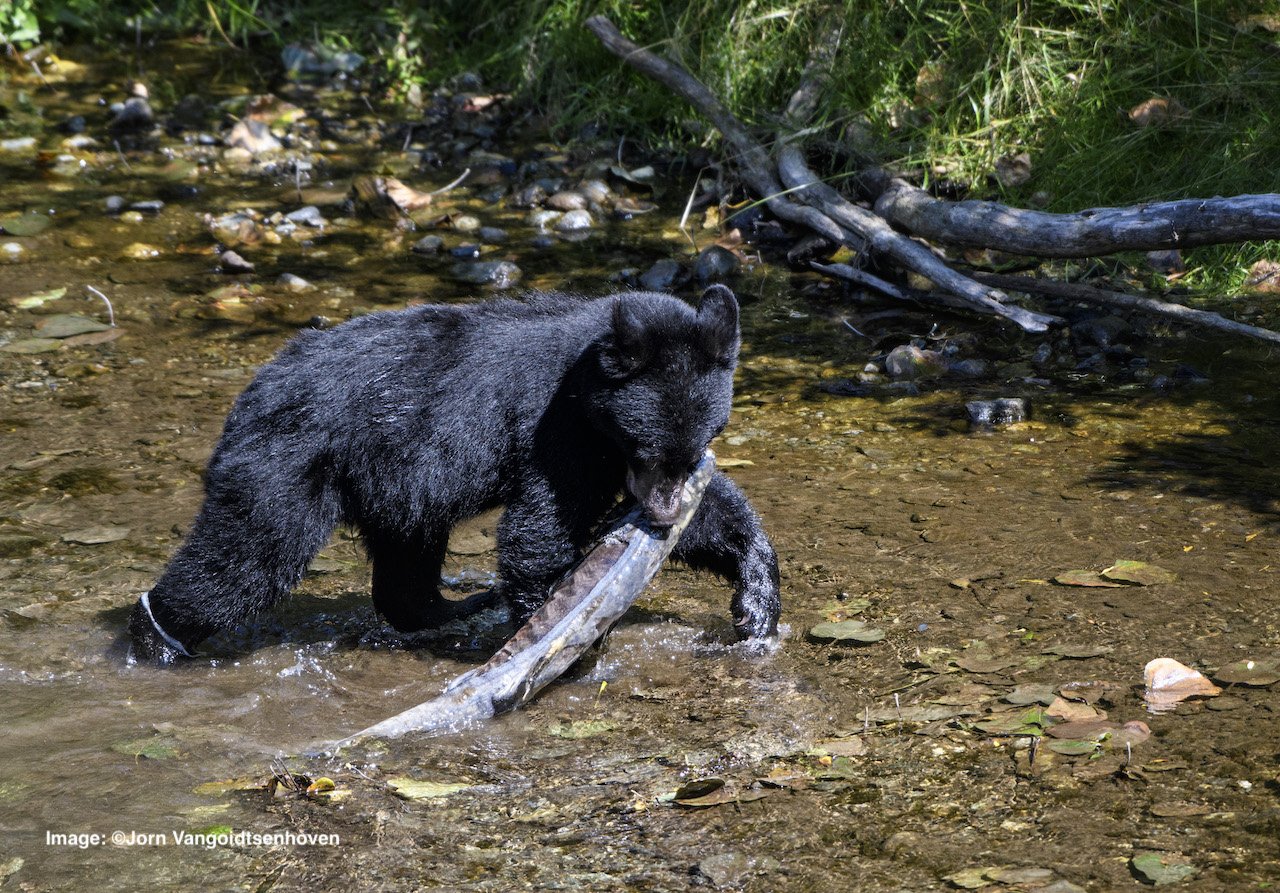The Best Place to See Fishing Bears
When the salmon return back to their natal streams and creeks to spawn, the bears are ready and Hyder, Alaska, is the best place to catch the action. Image: ©Jorn Vangoidtsenhoven
Wildlife photographer and team member, Jorn Vangoidtsenhoven.
by Jorn Vangoidtsenhoven
This is a story about "sucker holes," "torpedo" chum, and hungry bears all in a fantastic place, situated deep in a rain forest, where the few people hardy enough to call this place home are outnumbered every summer by salmon and hungry predators.
This is the only place in Alaska, accessible by road, to safely witness the brown (grizzly) bears and other wildlife that gather to feast on the annual salmon spawn. Welcome to Hyder, the friendliest ghost town in Alaska.
Seeking “Off the Beaten Track”? Introducing Hyder, Alaska
Home to an estimated 80 steadfast souls, Hyder is located at Alaska’s southeastern tip, on the edge of the Tongass, America's largest national forest (part of the Prince of Wales Island - Hyder Census Area) It is at the head of the Portland Canal, a 71-mile (114 km) long fjord and the end point of Hwy 37A. The town is 41 miles (66 km) from the famous Cassiar Highway, 207 miles (332 km) from the nearest “big” town (Smithers, British Columbia, Canada, population 5,351), 929 miles (1487 km) from Calgary, Alberta, Canada and 925 miles (1480 km) from Vancouver, British Columbia, Canada. If you are seeking, “off the beaten track,” Hyder is your destination.
The near ghost town is sometimes nicknamed "Budget Brooks Falls," a nod to its salmon fishing bears. Hyder is the Alaskan town nearest to the lower 40 States that is reachable by car. Image: ©Jorn Vangoidtsenhoven
✔︎Trip Tips
Where: Hyder, Alaska,
Why: "Fish Creek Wildlife Observation Site" spawning salmon, and a variety of predators, including grizzly bears.
Best Time: The salmon spawn: Mid-July through mid-September
How to get there? By car or by float plane from Ketchikan, Alaska
The End of the Road is Just the Beginning
Hyder is literally at the end of the road – the only way out is the same way you came in. Driving in from Canada, there is no immigration or customs office, just a "Welcome to Alaska" sign
Hyder and its Canadian neighbor, Stewart, (bring your passport) are true boom and bust towns, both founded in the early 1900s with the discovery of gold, silver, and copper in the nearby mountains. After the Canadian Granduc mine closed in the 1980s, Hyder's economy crashed.
Today, the town’s economic saving grace sits 4 miles outside of town: Fish Creek, a small, spring-fed creek that attracts thousands of tourists annually. They come to see the summer salmon runs and the predators that gather to feed on the fish including brown bears (or grizzlies), black bears, wolves, and eagles. And the best place to see the action is the Fish Creek Wildlife Observation Site.
One of America’s most breathtaking places, the Salmon River (looking toward Misty Fjords) near Hyder, Alaska. Image: ©Jorn Vangoidtsenhoven
Why is Hyder called the "Budget Brooks Falls?"
Brooks Falls in Katmai National Park is where hungry brown bears stand on top of the falls, waiting for salmon to jump into their mouths.
But getting to Katami is expensive. There is no road into the Park, so getting there typically requires a float plane ride, and recent ticket prices are averaging around $900 per person. For this, you are allowed three or four hours on the ground in the Park to watch the bears.
Interested in visiting Hyder? Let us know
On the other hand, once you drive your car to Hyder, it is only $6 (yes, six dollars!) to watch bears for a full day. And the Forest Service has made it easy.
In the 1980s and '90s, the salmon-filled Fish Creek became so popular with photographers and tourists who freely mingled with the hungry bears (surprisingly, no one ever got hurt!) that by the early 2000s, the National Forest Service built a 600-foot (183 m) wooden boardwalk. The Fish Creek Wildlife Viewing Site platform is located about 4 miles (6.5km) outside town and safely separates humans from predators.
On the Canadian side of the border, about 23 miles (37km) from Hyder, Hannah Vangoidtsenhoven and Sophie take in The Salmon Glacier. Image: ©Jorn Vangoidtsenhoven
Know Before You Go. Hyder is a Wet Place
✔︎Trip Tips, Continued How? Tickets for the platform must be purchased online IN ADVANCE. NOTE: at time of writing, NO internet at the site. Internet is available in a few places in Hyder or Stewart, or buy prior to arrival.
Platform Rules: Here
Bonus: Close-by, beautiful Bear Glacier and Salmon Glacier are both road accessible.
Hyder is located in the Tongass National Forest, North America's only temperate rainforest: it rains a lot, up to 92 inches per year.
After days of constant rains, when a tiny spot of blue sky appears as a break in the clouds, you may be inclined to think that – finally – the skies are clearing up, and you can take off your rain clothing.
Wrong: in no time, the blue spot is gone, and the rain is back; hence the phenomenon appropriately termed "sucker hole" by the locals. All of this to say: be prepared.
I like to "dress" my camera and lens in a full raincoat. Warning: A large plastic bag can do the trick, but the noise a plastic bag makes can scare the wildlife away. Back in the day, when a plastic bag over my equipment was all I had, a grizzly bear in the creek actually looked up at me when I noisily removed it
Tip: Invest in proper protection for your equipment against the Tongass’ damp and wet, the bears are not amused by the rustle (or mess) of plastic bags. Image: ©Jorn Vangoidtsenhoven.
Best Way to Identify Salmon Species? Use Your Fingers
Hyder is home to three of the five salmon species living in Alaskan waters. Here's a trick to remember what they are: look at the fingers on your hand. 1) Your thumb sounds like "chum" (or dog); this is the first kind of salmon. 2) Your index finger can "poke you in the eye" ("poke-eye"), hence the second kind of salmon, "sockeye" (or red). 3) Your middle or longest finger reminds of the largest salmon, "king" (or Chinook). 4) Your "ring" finger reminds you of precious metal, hence "silver" (or coho) salmon. 5) Your pinky finger finally corresponds with "pink" (or humpy) salmon.
✔︎ Trip Tips, Continued
Where to stay? Hyder, has limited accommodations. Across border into neighboring Stewart, British Columbia for hotels, motels, RV parks, and B&Bs, grocery stores, and restaurants.
The Best Time to See Salmon and Bears in Hyder
July: In Hyder's Fish Creek, July marks the arrival of the chum salmon run: this is Fish Creek's claim to fame as the chum that arrives to spawn here is the largest in North America, up to 40 pounds!
August: a bigger run of pink salmon joins the chum, and sometime in late September, a smaller run of coho salmon arrives.
All salmon spend most of their adult lives in the ocean but return to the creek where they were born to spawn. So how do they know what creek is "their" creek? Scientists think it may be the smell of the water.
Once the salmon return, leaving the salt and re-entering the freshwater of their natal creek, they stop eating, and their bodies undergo a remarkable transformation. Both genders change colors, but the males grow sizable, hooked teeth and become almost unrecognizable.
Salmon, like this chum in Fish Creek, Hyder, Alaska, spend most of their adult life in the ocean, then return to their natal creek to spawn and die. Image: ©Jorn Vangoidtsenhoven
The females dig a nest or a "redd," by rubbing their side in the shallow, flowing, gravel-bottomed stream. There she deposits her eggs which the male will inseminate with a cloud of sperm.
Males fight each other using their newly grown teeth to maneuver into a prime position behind the female.
The salmon stay in the creek to protect their nest but die after about two weeks. Their decaying bodies complete the circle of life by providing nutrition for other predators and creek-side vegetation and the babies (or "fry") that will emerge next spring.
Spawning is a Dangerous Business for Salmon
Once they return to spawn, salmon face a gauntlet of hungry predators, like this bald eagle, hunting from the air, land, and in the water! Image: ©Jorn Vangoidtsenhoven
First, they must survive countless dangers lurking in the ocean – including Alaska's salmon industry and make it back to the creek where they were born. Once there, spawning in the shallow waters makes them easy prey for various predators. Grizzly (or brown) bears, black bears, wolves, bald eagles, the odd wolverine, mink, mew (renamed “Short-billed” in 2021) gulls ... all want a piece of them. Then we humans, with cameras in hand, come to witness the spectacle. And quite a spectacle it is.
Follow the Action at The Fish Creek Wildlife Viewing Site
The platform, built in 2002, has a perfect safety record. It allows you to come face to face with a 500-pound (227kg) grizzly bear and, under the supervision of dedicated National Forest Service employees and volunteers, watch or take thousands of images as the bears' chase and catch salmon all over the creek.
This past summer, I became a volunteer: it was an amazing experience. Not only was I able to spend 8 hours daily on the platform observing all of the natural wonders, but I could also interact with and help educate the other viewers by answering their many questions such as:
Why do the salmon die? (they stop eating after leaving the ocean, and use all their energy to travel up the creek and spawn.) Why do the bears catch and kill a salmon, only to dump it in the creek without eating it? or Why doesn't the Forest Service clean up the dead salmon? (the decomposing salmon provide vital nutrients to the water, they nourish newly hatched salmon babies and up to 137different species of mammals to microbes. Look here for more interesting salmon facts
[A special thanks to Eric Abele, the site supervisor, who does a great job year after year keeping everyone safe and allowing visitors the unique opportunity of seeing nature at work.]
Locals and tourists gather yearly in the 600ft platform to safely watch the bears and other wildlife feed on the spawning salmon.
Young Males + No Mama Bear = Trouble!
At about 2 1/2-years years old, brown bear cubs are “shown the door” by their mothers, it is time to fend for themselves. But, grizzlies, especially the males, “kicked out” by their mom can be tricky to handle. These newly alone young bears, trying to decide between being playful or dominant, test the boundaries of what's allowed.
Without their mom to correct bad behavior with a growl or a swat, these young bears are prone to getting into trouble (surprise!) And that was the case this past summer when a bear dubbed "troublemaker" tried to climb the wooden platform while people were standing on it - twice!
Young males grizzlies, like other young mammals, young elephants, lions, humans (!) push boundaries and can find themselves into trouble. Eventually they grow up! Image: ©Jorn Vangoidtsenhoven
Finally, as "troublemaker" was making his way up once again, a National Forest Service staff member sprayed him with pepper spray. The spray, proven to be the most effective way to stop a grizzly bear, worked. But, if you think getting pepper-sprayed in the face at short range would send the bear running for the hills, think again.
The young grizzly climbed back down, went back into the creek, put his head into the water, and continued his salmon fishing. He was a regular bear there for the rest of the season, but he did get the message to leave the humans on the platform alone.
Counting Fish and Dodging Bears
Counting the fish means getting into the water with the bears - a somewhat disconcerting process but one that is done 3 times every season. Image: Jorn ©Vangoidtsenhoven
Once you see a few bears catching and eating salmon in the creek from the safety of the platform, you'd likely conclude that you should stay out of said creek. Why would anyone deliberately put on waders and walk in the water between the bears?
Well, three times every summer, that's exactly what happens. A group of about 5 National Forest Service and Alaska Fish and Game staffers grabs their clickers and walk the entire length of Fish Creek, counting the number of live and dead chum and pink salmon.
On last season's second fish counting excursion, I joined them.
The Greatest Threat Turned Out to be Torpedoes
Brown bear half hidden on the banks of the Fish Creek watches the human counters in “his” water. Image: ©Jorn Vangoidtsenhoven
While everyone carries bear pepper spray on their belt, and two of the group carry shotguns, I couldn't help but be a little apprehensive on the three-hour creek walk, expecting a big grizzly to come charging out of the rain forest at any time.However, the greatest danger came from the fish.
As you walk the creek, the salmon quickly dart out of the way. Having a 40-pound chum salmon hit your ankle is enough to topple you into the icy-cold water; hence they are appropriately dubbed "torpedo chum."
The bears do provide a few surprises, though. A few years ago, as the fish counters approached the platform near the end of the creek, a Forest Service ranger, carrying a shotgun and standing on the platform, spotted a grizzly bear fishing in the water nearby.
He got on the radio to alert the fish counters: "Beware; there is a bear in the creek. He just caught a fish, and he's heading in your direction."
While teams of Forest Service rangers and staffer walk the river to count the fish three times during the season, bears have other things in mind. Image: ©Jorn Vangoidtsenhoven
The fish counters had nowhere to go when the bear, carrying a salmon in its mouth, walked from the bank into the creek right on top of them.
The counter in the lead came suddenly face to face with the big grizzly. "As I couldn't get a hold of the shotgun or pepper spray fast enough, I did the only thing I could come up with: I said "WOOF!!" in a very loud voice."
As the shotgun-carrying ranger who saw the whole thing happen from the platform, says: "This was the only time in my career that I thought I would have to shoot a bear, but, when the fish counter shouted WOOF, the bear was so surprised that he dropped the fish at his feet and took off running in the opposite direction. The bear was literally sprinting on top of the water to get away!"
(I wonder whose heart was pounding harder?)
The “Blue Lagoon” from the Fish Creek Observation Viewing Site. Image: ©Jorn Vangoidtsenhoven
Jorn’s Tips for Preparing Photography Equipment for the Rainforest
Going to Hyder? Here are my recommendations for photographing the bears and salmon at Fish Creek:
It's a rainforest. Bring adequate rain protection for your gear.
Frequently cloudy skies and salmon-chasing bears dictate the need for light-sensitive equipment. Bring a camera body that can handle high ISOs well and a variety of lenses with a large aperture or F-stop: f/2.8 or f/4 lenses are great, f/5.6 is borderline too slow to catch fast action in dark conditions.
As the bears and other predators chase the salmon, use a camera body that supports a high frame rate: 10 fps or more works well to capture that defining moment.
Recommended focal lengths range from 100mm to 600mm. Bigger lenses allow you to get close-up shots, while 100mm will enable you to include scenery.
While tripods are allowed on the platform, they can hamper your movements, especially during busy times. I recommend a camera and lens you can handhold or support on a monopod.
Bring warm, weatherproof clothing. Even in the middle of summer, daytime temperatures can be in the 40s or 50s. Combined with wet, damp weather, you'd be surprised how cold it can feel!
And don't forget your sense of humor!
Be ready to experience the bears. See Jorn’s tips on preparing your photography equipment above. Image: ©Jorn Vangoidtsenhoven
We love your feedback - share your thoughts and comments below!



